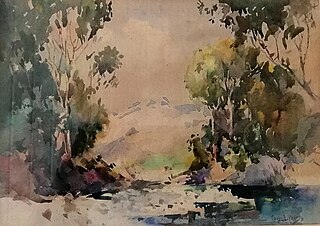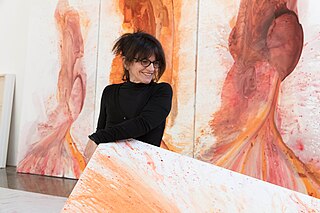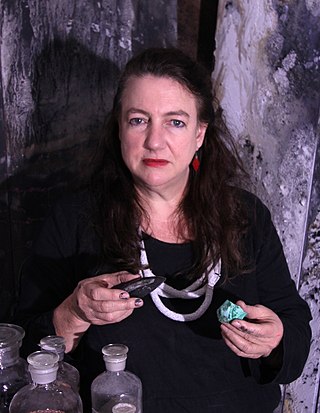Related Research Articles
Lionel Davis is a visual artist, teacher, and public speaker from South Africa. He was born in Cape Town, South Africa, in 1936 in the infamous District Six neighborhood. He was a prominent figure in the anti-apartheid movement, and was incarcerated for seven years on Robben Island, an infamous prison for political prisoners under the apartheid regime. It was here that Davis met Nelson Mandela.
Buysile "Billy" Mandindi (1967–2005) was a black South African activist-artist who participated in a landmark protest in Cape Town in 1989, the so-called Purple Rain Protest. Later, still covered with the purple dye that riot police sprayed on protesters, Mandindi created a linocut celebrating the spirit of freedom.
Peter Clarke was a South African visual artist working across a broad spectrum of media. He was also a writer and poet.
Rorke's Drift Art and Craft Centre is a center for arts and crafts, including fine art, printmaking, pottery and weaving, located in KwaZulu-Natal, South Africa. It has been described as "the most famous indigenous art centre in South Africa".
Philippa Hobbs is a published South African art historian, an artist and an art collector. She was born in 1955 and matriculated at St Andrew's School in 1972. She studied art at the Johannesburg College of Art before finishing a post-graduate printmaking course at the University of the Arts (Philadelphia). She then furthered her studies through University of South Africa (UNISA) and the Technikon Witwatersrand. Hobbs was a senior professor of history of art at the University of the Witwatersrand in Johannesburg from 1988 to 1993. She has been noted for her contribution to the practice of art, art education, research and, most recently, community development through art. Hobbs currently works as MTN art collection curator and arts and culture portfolio senior manager.

Diane Victor, is a South African artist and print maker, known for her satirical and social commentary of contemporary South African politics.

Kathryn Smith is a South African artist, curator, and researcher. She works on curatorial projects, scholarly research, and studio practices, while her art deals with uncertainty, risk, and experimentation. She works in Cape Town and Stellenbosch. Her works have been exhibited and collected in South Africa and elsewhere. In 2006, she was appointed senior lecturer in the Department of Visual Arts at the University of Stellenbosch and head of the Fine Arts Studio Practice program. She took a break in 2012/2013 to read for an MSc at the University of Dundee.

Charles Ernest Peers was a South African artist.

Penny Siopis is a South African artist from Cape Town. She was born in Vryburg in the North West province from Greek parents who had moved after inheriting a bakery from Siopis maternal grandfather. Siopis studied Fine Arts at Rhodes University in Makhanda, completing her master's degree in 1976, after which she pursued postgraduate studies at Portsmouth Polytechnic in the United Kingdom. She taught Fine Arts at the Technikon Natal in Durban from 1980 to 1983. In 1984 she took up a lectureship at the University of the Witwatersrand in Johannesburg. During this time she was also visiting research fellow at the University of Leeds (1992–93) and visiting professor in fine arts at Umeå University in Sweden (2000) as part of an interinstitutional exchange. With an honorary doctorate from Rhodes University, Makhanda – Siopis is currently honorary professor at Michaelis School of Fine Art, University of Cape Town.
Deborah Bell is a South African painter and sculptor whose works are known internationally.
John Ndevasia Muafangejo was a Namibian artist who became internationally known as a maker of woodcut prints. He created linocuts, woodcuts and etchings.
iQhiya is a network of young black women artists based in Cape Town and Johannesburg, South Africa. They specialise in a broad range of artistic disciplines including performance art, video, photography, sculpture and other mediums.

Zelda Nolte (1929–2003) was a South African- British sculptor and woodblock printmaker.

Jeannette Unite is a South African artist who has collected oxides, metal salts and residues from mines, heritage and industrial sites to develop paint, pastel and glass recipes for her large scale artworks that reflect on the mining and industrial sites where humanity's contemporary world is manufactured.
Kagiso Patrick "Pat" Mautloa is a multi-media visual artist based in Johannesburg, South Africa.

Senzeni Marasela is a South African visual artist born in Thokoza who works across different media, combining performance, photography, video, prints, textiles, and embroidery in mixed-medium installations. She obtained a BA in Fine Arts at the Wits School of Arts, University of the Witwatersrand, Johannesburg in 1998. Her work is exhibited in South Africa, Europe, and the United States, and is part of local and international collections, including Museum of Modern Art or the Newark Museum and is referenced in numerous academic papers, theses journal, and book publications.
Mmakgabo Mmapula Mmangankato Helen Sebidi is a South African artist born in Marapyane (Skilpadfontein) near Hamanskraal, Pretoria who lives and works in Johannesburg. Sebidi's work has been represented in private and public collections, including at the National Museum of Women in the Arts, Washington and New York the Smithsonian National Museum of African Art, New York, and the World Bank. Her work has been recognised internationally and locally. In 1989 she won the Standard Bank Young Artist award, becoming the first black woman to win the award. In 2004, President Thabo Mbeki awarded her the Order of Ikhamanga in Silver – which is the highest honor given to those considered a "national treasure". In 2011, she was awarded the Arts and Culture Trust (ACT) Lifetime Achievement Award for Visual Art, whilst in 2015 she received the Mbokodo Award. In September 2018, Sebidi was honoured with one of the first solo presentations at the Norval Foundation in Cape Town – a retrospective entitled Batlhaping Ba Re.
Allina Ndebele is a South African artist and weaver known for her tapestries. She was born in Swart Mfolozi in KwaZulu Natal Province and after training to be a nurse se she secured a job as a translator for Peder and Ulla Gowenius who were in the process of setting up what was to be Rorke's Drift Art and Craft Centre. She quickly picked up weaving and studied in Sweden to become a teacher-weaver. She later went on to establish her own weaving studio, Khumalo's Kraal and obtained the Order of Ikhamanga in Silver in 2005. She still lives at Khumalo's Kraal today.
Sam Nhlengethwa South African creative collage artist and the co-founder of Bag Factory Artists' Studio.
Phumzile Khanyile is a South African photographer, living in Johannesburg. Her series Plastic Crowns is about women's lives and sexual politics. The series has been shown in group exhibitions at the Palace of the Dukes of Cadaval in Evora, Portugal; Iziko South African National Gallery in Cape Town; and the National Gallery of Victoria in Melbourne, Australia; and was a winner of the CAP Prize for Contemporary African Photography,
References
- 1 2 3 4 "Bongiwe (Bongi) Dhlomo-Mautloa". www.sahistory.org.za. South African History Online. Retrieved 31 January 2021.
- 1 2 3 4 Koloane, David (21 March 2000). "Dhlomo-Mautloa, Bongiwe". Oxford Art Online. doi:10.1093/gao/9781884446054.article.T096572.
- ↑ "Bongiwe Dhlomo-Mautloa". Asai. Africa South Art Initiative. Retrieved 31 January 2021.
- 1 2 Arnold, Marion (1 January 2011). "Cutting anti-apartheid images: Bongiwe Dhlomo's activist linocut prints". In Hoskins, S. (ed.). IMPACT 6 Multi-disciplinary Printmaking Conference Proceedings. Impact Press. pp. 131–136. Retrieved 31 January 2021.
- ↑ Khumalo, Juniour. "Siya Kolisi, Desiree Ellis, Tracy Chapman among 32 bestowed national orders by Ramaphosa". News24. Retrieved 2 May 2023.